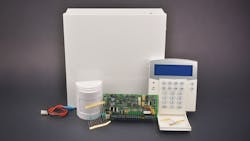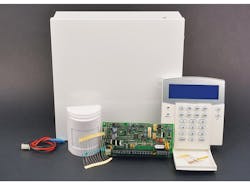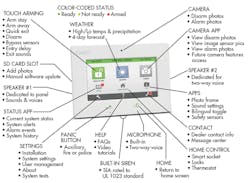This file type includes high-resolution graphics and schematics when applicable.
In recent years, the user experience of consumer electronics, new government legislation, and the push for increased system efficiency have conspired to drive significant advances within in-building security or intrusion-detection systems. Traditional sensor types, connectivity, control interfaces, and power sourcing have all been affected to varying degrees, significantly shifting the look, feel, and operation of these somewhat ubiquitous applications.
Historically intrusion-detection systems were mostly a simple wired set of hardware consisting of control panels, door/window contacts and perhaps a passive motion sensor or two that carried minimal software integration and/or operational intricacy (Fig. 1). Over the past decade, though, both residential and commercial building customer demands have influenced the complexity and utility of the individual components, as well as the complete functionality of these system solutions.
Legislative Matters
One of the first drivers of this evolution was new government legislation being enacted in many regions of the world, specifically in the developing world and countries where a large chasm exists between the classes of population. Most impactful has been a mandate that first-order threat verification must be conducted prior to the dispatching of emergency services. This was due to a significant increase in the false alarm rates and erroneous deployments of municipal resources (police, fire, EMS, etc.).
To adhere to this mandate, two separate but connected actions were undertaken:
• System-development OEMs added new sensor technology to the hardware itself.
• System service providers enhanced the level of remote monitoring by human personnel.
Here’s an example of how these actions have manifested themselves: Traditional motion sensors were based on a single- or dual-pixel passive infrared (PIR) sensor element. PIR sensors operate by identifying changes in heat signatures within a field of view. Though quite acceptable for some use cases, passive-infrared (PIR) sensors are limited to the mere detection or presence of stimuli—human, pet, vehicles, etc.—but they can’t identify the type of source that’s been detected. To distinguish or classify the detected objects, additional sensor technology must be added to the system.
In an effort to address this need and increase the overall accuracy, reliability, and performance of the entire system, image-capture capability was added to an increasing percentage of security motion-sensor nodes (Fig. 2). The PIR sensing element remains present, but in this advanced configuration, the PIR acts as a trigger to wake up the image capture subsystem. The subsystem then grabs an image frame or two, which are subsequently sent to a remote-monitoring station for verification.
Upon receipt at the service provider’s operations center, round-the-clock human security employees are tasked with checking the transported images to verify whether the stimuli that tripped the alarm indeed presents a threat or “alarm condition.” Only after this verification step has been completed will emergency services be dispatched.
As an extension to the functionality of the image-capture capability being included at the edge of the network within individual sensor nodes, local processing integration is now being deployed to enable local threat analysis and verification. This additional layer of intelligence provides reduced decision-making latency and enables the data-transmission bandwidth to be significantly lower as now mere bits of data (flags, interrupts, and notifications) need to be transmitted rather than bytes of data (multiple image frames).
Going Wireless
Another major advance in the in-building security solutions sector has been the move from wired to wireless interfacing—not only between the individual sensor nodes and the control panel, but also from the entire system deployment to its associated remote-monitoring station or operations center. For many decades, the sensor-to-panel connection was made using low-voltage serial wiring, most often of the RS-485 variety commonly found in many other building control applications. Such hardwired interfacing required significant effort, and cost steadily rose for system installation.
With the advent of very-low-power, short-range wireless technology, a number of manufacturers extended their hardware system portfolios to include wireless-system versions, enabling much easier initial deployments. This shift, in turn, has reduced implementation time as well as cost. And by extension, it’s opened up a significantly larger market size by allowing reasonable retrofit installations, rather than the market being largely driven by new construction sales.
Furthermore, in the area of back-end connectivity, the intrusion-detection-system market—which was exclusively aligned to a phone line or POTS connection to the remote-monitoring station or operations center—has evolved to leverage Wi-Fi/gateway internet links as well as terrestrial mobile-phone network connections. It’s widened the playing field of deployment options while also eliminating the hard requirement of landline phone connections being present for intrusion-detection-system installations.
Advanced User Interface
One other area within the in-building security equipment space that’s evolved significantly is the user interface. Only a short time ago, intrusion-detection-system control panels were comprised of simple pushbutton and dial interfaces. However, with smartphone and tablet use now pervasive across nearly all target consumer demographics, the user experience of residential- and commercial-building control equipment, including intrusion-detection systems, thermostats, and smoke detectors, has leapt into the 21st century.
Although most OEMs still offer entry-level, no-frills equipment options, the mid-range and high-end offerings now include features like touchscreens, backlit keypads, ambient-light sensing, and voice-control capabilities (Fig. 3). Most of these features clearly address the look and feel elements of the system’s performance. However, the utility and operational value of features such as ambient-light sensing can also address the critical areas of system power consumption and operating expenses over a product’s lifetime—sometimes referred to as “total cost of ownership.”
While these features can be viewed as incrementally driving up overall system cost, demand necessitates feature additions to match expectations set through 24/7 consumer-electronics utilization. Thus, OEMs have responded by integrating consumer-electronics-related features into their hardware materials.
Today’s top-of-the-line system would be largely unrecognizable to consumers as a whole from only 20 years ago. Real-time on-demand activation, local threat verification, wireless connectivity, high-resolution control-panel displays, advanced user interfaces (with voice control), remote-monitoring capabilities complete with streaming video feeds, and a new array of sensor elements (offering shock, vibration, and acoustic event detection) have transformed the landscape of this industry in a relatively short period of time.
All of these advances outlined above can’t come at the expense of increased system power consumption, though. As the data and control interfaces between sensors and panels moves from wired to wireless, a continued reliance on ac power sources and wired tethering is a complete and utter nonstarter.
As a result, many OEMs are applying two power-optimization approaches—using stacked batteries for increased capacitance, while operating certain portions of the system in a duty-cycled manner. They not only increase the value and utility of in-building security systems, but maintain power budgets that could be served through battery/dc power sources, whether standalone or combined with energy-harvesting capabilities such as subsystems based on high-efficiency, photovoltaic-cell-harvesting elements.
Platforms of the Future
When reviewing the multiple areas of upgrade and evolution of in-building security or intrusion-detection systems covered here, a strong push can be made to generate new technology “platforms” to integrate and promote many or all of these innovative advances within a single vehicle. This is true for both the end-equipment manufacturers as well as for the solution providers to the intrusion-detection-system equipment market.
These platforms can serve as the foundation of next-generation hardware projects for manufacturers and/or as a reference design from solution providers. The latter would help smooth transition from existing technology to some of the advances outlined in this article while simultaneously speeding time-to-market for adopting customers.
Clear alignment between many of the innovations and technology advances, as well as the underlying market requirements, can be drawn with the technologies being developed by Analog Devices Inc. (ADI). Whether rooted in the signal-conditioning and signal-conversion functions, which are traditional strongholds of the company, or the more recent focus areas of digital processing and power management, ADI can help enable the scaled requirements faced by in-building security/intrusion-detection-system equipment manufacturers when developing their next-generation platform architectures.
Michael Long is Smart Building & Smart City Strategy Manager, IDS Business Unit/AES Division, for Analog Devices Inc., www.analog.com.
Looking for parts? Go to SourceESB.




